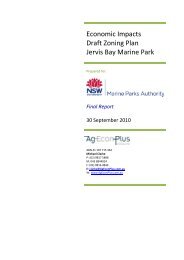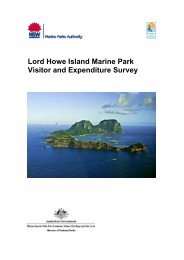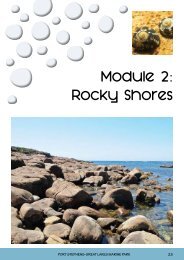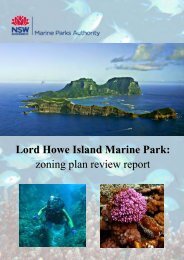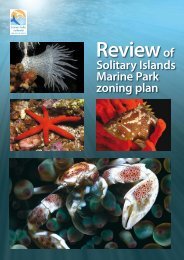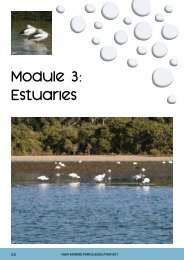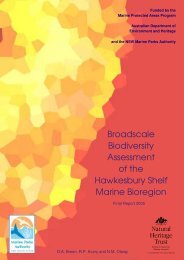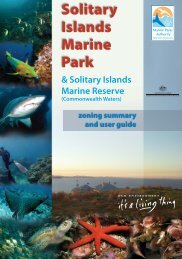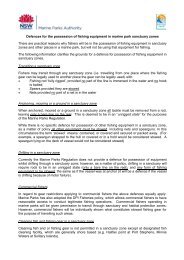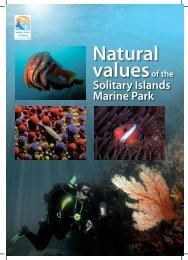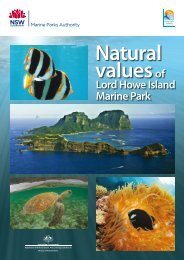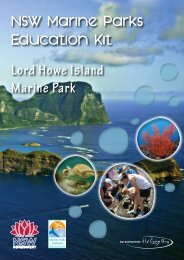Research Project Summaries 2002-2009 - Marine Parks Authority ...
Research Project Summaries 2002-2009 - Marine Parks Authority ...
Research Project Summaries 2002-2009 - Marine Parks Authority ...
You also want an ePaper? Increase the reach of your titles
YUMPU automatically turns print PDFs into web optimized ePapers that Google loves.
noted that colonies of Turbinaria mesenterina and T. frondens (dominant coral speciesat inshore and mid-shelf island reefs) bleached when seawater temperatures exceeded26°C. However, coral mortality only occurred in colonies bathed in seawater above28°C, following three weeks of higher temperatures. While mass bleaching alsoaffected dominant corals throughout the GBR in <strong>2002</strong> and 2006, only low levels ofbleaching occurred in the marine park. Edgar et al (2003) indicated only minorbleaching in some susceptible species such as pocilloporids and acroporids between2000 and 2003. Dalton (2010) found that between 2004 and 2006, bleaching increasedduring summer and was more prevalent in branching corals such as pocilloporidscompared with tabular and encrusting morphs.The sea temperature monitoring program found sea temperatures to be highest in <strong>2002</strong>and 2006 at 27.5°C. The warmer temperatures in <strong>2002</strong> were related to a pulse of warmwater generated in the Coral Sea and responsible for the GBR’s strongest recordedbleaching event. However, in <strong>2002</strong> high sea temperatures dropped away rapidly, whichmay have prevented extensive bleaching in this marine park. Overall, 2006 had thegreatest range in sea temperature and appeared to have the strongest seatemperature variability. The yearly average sea temperature was highest in 2005 and2006 at the offshore site. The maximum temperature was highest in 2006 at both theoffshore and mid-shelf sites but not the inshore site. There is a strong correspondencebetween the position of the EAC, cold water intrusions and sea temperature.Temperature can also vary strongly within defined hours, with differences up to 6.5°Crecorded in less than 24 hours at North Solitary Island (Malcolm et al in review a).2.2 Jervis Bay <strong>Marine</strong> Park2.2.1 Habitat knowledgeSeabed habitat mapping projects conducted in Jervis Bay <strong>Marine</strong> Park since <strong>2002</strong> buildon earlier work on soft-sediment habitats (West et al 1985, CSIRO 1994) andnearshore reefs (see Breen et al 2004). Firstly, mapping of estuarine aquaticmacrophytes (seagrass, mangrove and saltmarsh) was completed throughout themarine park as part of the statewide Comprehensive Coastal Assessment (West et al2006). Mapping consisted of digitising habitat boundaries from existing aerialphotographs, with boundaries and dominant species composition confirmed throughground truthing. Around 40 square km of seabed was also recently mapped usingswath acoustic techniques. Much of this was conducted by the NSW Department ofEnvironment, Climate Change and Water using an interferometric side-scan sonar,although a large area offshore of Beecroft Head was mapped by Geoscience Australiausing a multibeam sonar system. In brief, swath acoustic mapping revealed extensivesubtidal rocky reefs throughout the marine park, with many extending immediatelyadjacent from the Bherwerre and Beecroft Peninsulas and offshore from CurrarongBeach and Wreck Bay. Subtidal habitats were categorised into consolidated (rockyreef) and unconsolidated (primarily sand and seagrass) areas in two depth zones:shallow (0–25 m) and intermediate (25–60 m). This information was combined toprovide a map of the known distribution of seabed habitats in the Jervis Bay <strong>Marine</strong>Park (Figure 2.). Further specific details of the distribution, extent and structure ofseabed habitats in the marine park are presented in NSW MPA (2010a).2.2.2 Biodiversity assessmentThe Jervis Bay <strong>Marine</strong> Park region is widely recognised as having high biologicaldiversity in a range of habitats including intertidal and subtidal reefs, soft-sediments,beaches, seagrass beds, mangroves, saltmarsh, and pelagic waters. A detailed studyof the biodiversity and spatial and temporal structuring of assemblages associated withSolitary Island and Jervis Bay <strong>Marine</strong> <strong>Parks</strong> <strong>Research</strong> <strong>Project</strong>s <strong>Summaries</strong> <strong>2002</strong>–<strong>2009</strong> 13



